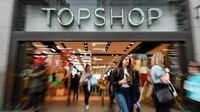After a turbulent few years that saw it vanish from the British high street, Topshop is stepping back into the spotlight with a bold new vision and a careful nod to its storied past. On August 15, 2025, the iconic brand officially relaunched its standalone website for the first time in four years, unveiling a 40-piece collection curated in collaboration with model and actress Cara Delevingne. The move marks the latest in a series of calculated steps to revive Topshop’s presence, both online and in bricks-and-mortar stores, and to recapture the hearts—and wallets—of a new generation of shoppers.
Topshop’s return is more than just a digital relaunch. This month, the brand began selling its clothes in McElhinney's, a department store in Ballybofey, County Donegal, Ireland. This marks the first time Topshop’s wares have been available in a physical store since its abrupt transition to an online-only model in 2021, following the collapse of Sir Philip Green’s Arcadia group and the brand’s acquisition by Asos. Michelle Wilson, managing director of Topshop and Topman, has been at the helm of these efforts, confirming that a semi-permanent physical presence is planned for August, following a successful one-day pop-up event back in April.
But the real buzz surrounds Topshop’s imminent high street comeback in the UK. According to the BBC, Wilson has confirmed that standalone stores will be reopening soon, with the aim of eventually rolling out nationwide. No specific dates have been given, but the message is clear: Topshop is ready to reclaim its place as a fixture in towns and cities across the country. The relaunch comes at a challenging time for the high street, with other retailers like Claire’s Accessories recently collapsing into administration. Still, the anticipation is palpable, with social media awash in nostalgia and excitement, especially among millennials and Gen-Z shoppers who remember Topshop as a rite of passage in their teenage years.
To celebrate its return, Topshop is hosting its first catwalk show in seven years on August 16, 2025, in London’s Trafalgar Square. The event will feature long-time brand muse Cara Delevingne and is expected to revive memories of the brand’s heyday, when launches—like the iconic Kate Moss Topshop collection—drew massive crowds and media attention. The move is as much about rekindling the brand’s cool factor as it is about drumming up publicity. As fashion journalist Amber Graafland told the BBC, “Topshop lost its cool. And when that happens, it's hard. Fashion is a fickle beast, people move on quickly.”
Wilson and her team are acutely aware of this challenge. They know nostalgia alone won’t guarantee success in a market transformed by fast fashion giants like Shein, whose UK sales surged by almost a third to £2 billion last year, with profits rising 56% to £38.3 million. At the same time, the British high street is now dominated by European heavyweights such as Zara and H&M. “If you look at the High Street now, there’s a strong Spanish presence, with the likes of Zara, and also a Swedish presence with H&M. When Arcadia collapsed, we lost that Britishness,” Graafland observed. She added that much of the high street is “playing it safe right now,” which could work to Topshop’s advantage if it can “get that cool edge back.”
The brand’s new approach—dubbed Topshop 2.0—reflects lessons learned from its collapse five years ago. Wilson has made it clear that the company will not rush to over-expand, a mistake that proved costly in the past. “We’re just making sure we do it in the right way so that we don’t over-expand ourselves,” she told the BBC. The focus now is on quality, sustainability, and ethical supply chains, even if that means higher prices. “We know that when we offer great fashion and great value for money then the product does sell very well, so absolutely no concerns about that,” Wilson said. She emphasized that the firm’s focus is “on the livelihoods of people within the supply chain that we partner with and also the environmental impacts of the brand.”
This shift toward higher prices and greater quality control marks a significant departure from Topshop’s earlier incarnation, which was known for delivering chic styles at affordable prices. Today, a pair of Topshop jeans might set a shopper back £50, compared to £17 for a similar pair from Shein. Wilson acknowledged the difference, stating, “If we’re just comparing Shein, then yes, I think most brands on the planet are at a higher price point than Shein.” But she argues that the higher prices reflect a more sustainable and ethical business model, which is increasingly important to younger, more ethically conscious consumers.
Topshop’s leadership is also keenly aware that their customer base has shifted. Its previous core following—teenage girls and young women in the 2000s and 2010s—are now in their late 20s and 30s. While the brand is banking on nostalgia to bring these shoppers back, it also recognizes the need to attract a new generation. “We want to deliver for those that are nostalgic for a brand that they felt like they lost,” Wilson said. “But we absolutely want to appeal to a new demographic as well.”
Wayne Hemingway, designer and co-founder of Red or Dead, recalled Topshop’s heyday as a period of innovation and excitement. “They brought in second hand clothes for example, that’s normal now, but back then it was seen as absolutely radical to have a shopping department store doing that,” he told Daily Business Group. “You had the collaborations, the London Fashion Walk catwalk, all this design and excitement at High Street prices. It was so fresh, everyone wanted to be part of it.”
Can Topshop recapture that magic? The brand’s team thinks so. “The most important thing that we won’t forget, and maybe got forgotten about towards the end of the previous era, is that product is everything. It has to be the best quality product, the most fashionable product for our customer base, and bringing that at good value,” Wilson said. Graafland agrees that Topshop’s core aesthetic—the London girl look—is back in style, and not many other retailers are offering it. “We still think there’s a huge gap in the market for that,” Wilson added.
Beyond fashion, Topshop aims to revive the sense of lifestyle and experience that once made its stores a destination. Graafland put it succinctly: “Fashion is only part of the story. It’s about selling a lifestyle and an experience. There’s got to be that buzz around it.” Whether Topshop’s new stores will echo the vibrant atmosphere of their predecessors—complete with music, makeup, and the energy of a Saturday afternoon—remains to be seen. But the hope is clear: to get shoppers through the doors, and, more importantly, to keep them coming back.
As Topshop embarks on its carefully planned comeback, the brand faces stiff competition and high expectations. Yet with a blend of nostalgia, renewed focus on quality and ethics, and a commitment to recapturing its signature style, Topshop is betting it can once again become a high street staple. Only time will tell if this new chapter will be as iconic as its last.






